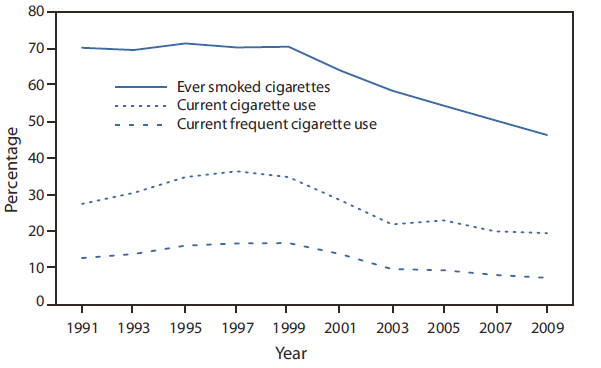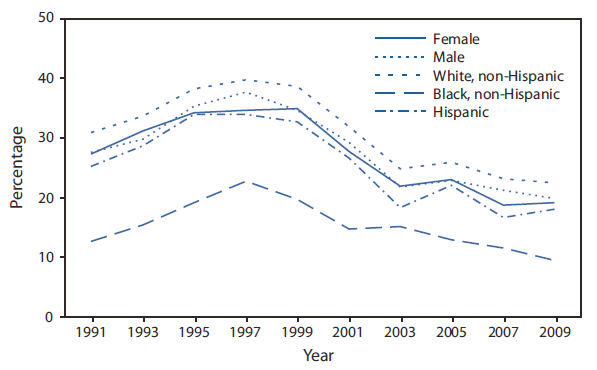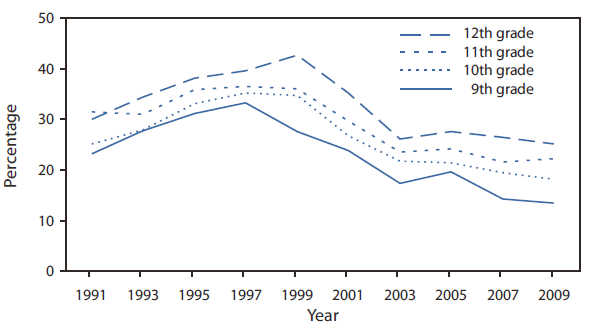Persons using assistive technology might not be able to fully access information in this file. For assistance, please send e-mail to: mmwrq@cdc.gov. Type 508 Accommodation and the title of the report in the subject line of e-mail.
Cigarette Use Among High School Students --- United States, 1991--2009
Understanding the trends in the prevalence of cigarette smoking among youths enables policy makers to target prevention resources more effectively. Every 2 years, CDC analyzes data from the national Youth Risk Behavior Survey (YRBS) to evaluate trends in cigarette use among high school students in the United States. This report updates a previous report (1) and describes results of CDC's 2010 analysis of YRBS data from 1991--2009 for three measures: ever smoked cigarettes, current cigarette use, and current frequent cigarette use. For ever smoked cigarettes, the prevalence did not change from 1991 (70.1%) to 1999 (70.4%), declined to 58.4% in 2003, and then declined more gradually, to 46.3% in 2009. For current cigarette use, the prevalence increased from 27.5% in 1991 to 36.4% in 1997, declined to 21.9% in 2003, and then declined more gradually, to 19.5% in 2009. For current frequent cigarette use, the prevalence increased from 12.7% in 1991 to 16.8% in 1999, declined to 9.7% in 2003, and then declined more gradually, to 7.3% in 2009. For all three measures, rates began to decline in the late 1990s, but the rate of decline slowed during 2003--2009. To increase the rate of decline in cigarette use among high school students, reductions in advertising, promotions, and commercial availability of tobacco products should be combined with full implementation of communitywide, comprehensive tobacco control programs (2--5).
The biennial national YRBS, a component of CDC's Youth Risk Behavior Surveillance System, used independent, three-stage cluster samples for the 1991--2009 surveys to obtain cross-sectional data representative of public and private school students in grades 9--12 in all 50 states and the District of Columbia.* For each survey, students completed anonymous, self-administered questionnaires that included identically worded questions about cigarette use. During 1991--2009, the number of participating schools ranged from 110 to 159, and the number of participating students ranged from 10,904 to 16,410. School response rates ranged from 70% to 81%, student response rates ranged from 83% to 90%, and the overall response rates ranged from 60% to 71%.
For this analysis, ever smoked cigarettes was defined as ever trying cigarette smoking, even one or two puffs; current cigarette use was defined as smoking cigarettes on at least 1 day during the 30 days before the survey; and current frequent cigarette use was defined as smoking cigarettes on 20 or more days during the 30 days before the survey. Race/ethnicity data were analyzed only for non-Hispanic black, non-Hispanic white, and Hispanic students (who might be of any race); the numbers of students from other racial/ethnic groups were too small for meaningful analysis. Data were weighted to provide national estimates, and the statistical software used for all data analyses accounted for the complex sample design. Temporal changes were analyzed using logistic regression analyses, which controlled for sex, race/ethnicity, and grade and simultaneously assessed linear, quadratic, and cubic time effects (p<0.05).†
Significant linear, quadratic, and cubic effects were detected for all three measures (Table 1 and Figure 1). The percentage of students who ever smoked cigarettes did not change from 1991 (70.1%) to 1999 (70.4%), declined to 58.4% in 2003, and then declined more gradually to 46.3% in 2009. The percentage of students who reported current cigarette use increased from 27.5% in 1991 to 36.4% in 1997, declined to 21.9% in 2003, and declined more gradually to 19.5% in 2009. The percentage of students who reported current frequent cigarette use increased from 12.7% in 1991 to 16.8% in 1999, declined to 9.7% in 2003, and then declined more gradually to 7.3% in 2009.
For current cigarette use, trend analyses were conducted by sex, race/ethnicity, and grade in school (Figures 2 and 3). Significant linear, quadratic, and cubic effects similar to the overall analysis were observed for current cigarette use among female students overall, white female students, black students overall, black male students, 9th-grade students, and 10th-grade students (Table 2). Among male students overall, white students overall, white male students, Hispanic male students, and 11th-grade students, current cigarette use increased from 1991 to 1997, declined from 1997 to 2003, and then remained stable. Among Hispanic students overall and Hispanic female students, current cigarette use increased from 1991 to 1995, declined from 1995 to 2003, and then remained stable. Among 12th-grade students, current cigarette use increased from 1991 to 1999, declined from 1999 to 2003, and then remained stable. Among black female students, only linear and quadratic effects were observed, indicating that the prevalence of current cigarette use increased from 1991 to 1999 and then declined, with no slowing or leveling off.
Reported by
Office on Smoking and Health, Div of Adolescent and School Health, National Center for Chronic Disease Prevention and Health Promotion, CDC.
Editorial Note
The findings in this report show that for three measures of cigarette use (ever smoked cigarettes, current cigarette use, and current frequent cigarette use), rates among high school students began to decline in the late 1990s, but the rate of decline slowed during 2003--2009. These trends are consistent with trends for 30-day and daily cigarette use reported from the Monitoring the Future survey (an ongoing national study of the behaviors, attitudes, and values of 8th-, 10th- , and 12th-grade students), which also showed declines starting in the late 1990s but gradual declines most recently (6). As a result of the slow declines in youth smoking described in this report, the Healthy People 2010 national health objective to reduce the prevalence of current cigarette use among high school students to ≤16%§ has not been met.
The findings in this report also show that since 2003 the rate of decline in current cigarette use slowed or leveled off for all racial/ethnic and sex subgroups except black female students, for which no slowing or leveling off occurred in the rate of decline after 1999. Cigarette smoking rates reflect complex and interrelated individual, social, and environmental factors (4,7). More detailed research is needed to explain why current cigarette use during 2003--2009 declined more slowly among some racial/ethnic and sex subgroups of high school students but remained stable among others.
The impact of tobacco advertising and promotion activities on youth smoking initiation has been documented previously (8). The increase in current cigarette use among high school students during the early to mid-1990s observed in this and other surveys might have resulted from expanded tobacco company promotional efforts, including discounted prices on cigarette brands most often smoked by adolescents, depictions of tobacco use in movies, distribution of nontobacco products with company symbols (e.g., hats and T-shirts), and sponsorship of music concerts and other youth-focused events (7). Reductions in advertising, promotions, and commercial availability of tobacco products should be combined with expanded counter-advertising mass media campaigns and implemented with other well-documented and effective strategies (e.g., higher prices for tobacco products through increases in excise taxes, tobacco-free environments, programs that promote changes in social norms, and comprehensive communitywide and school-based tobacco-use prevention policies)(2--5).
The findings in this report are subject to at least two limitations. First, these data apply only to youths who attend school and, therefore, are not representative of all persons in this age group. Nationwide, in 2007, of persons aged 16--17 years, approximately 4% were not enrolled in a high school program and had not completed high school (9). Second, the extent of underreporting or overreporting of cigarette use cannot be determined, although the survey questions demonstrate good test-retest reliability (10).
The Family Smoking Prevention and Tobacco Control Act (Tobacco Control Act),¶ enacted in 2009, provides new opportunities for broad scale reductions in tobacco use. This statute gives the Food and Drug Administration (FDA) additional authority to regulate the tobacco industry. The Act imposes specific marketing, labeling, and advertising requirements, and establishes restrictions on youth access and promotional practices that are particularly attractive to youth. The provisions of the Act offer opportunities for FDA to work as a partner in tobacco prevention and control (e.g., through collaborations with CDC and other federal and state agencies) (5). As suggested by the Institute of Medicine, the regulation of tobacco products is an important component of a comprehensive national tobacco prevention and control strategy that will complement and strengthen the impact of traditional, evidence-based interventions (4).
References
- CDC. Cigarette use among high school students---United States, 1991--2007. MMWR 2008;57:686--8.
- Zaza S, Briss PA, Harris KW, eds. Tobacco. In: The guide to community preventive services: what works to promote health? New York, NY: Oxford University Press; 2005. Available at http://www.thecommunityguide.org/tobacco/default.htm. Accessed July 1, 2010.
- CDC. Best practices for comprehensive tobacco control programs---2007. Atlanta, GA: US Department of Health and Human Services, CDC; 2007. Available at http://www.cdc.gov/tobacco/tobacco_control_programs/stateandcommunity/best_practices. Accessed July 1, 2010.
- Institute of Medicine. Ending the tobacco problem: a blueprint for the nation. Washington DC: National Academies Press; 2007.
- CDC. CDC grand rounds: current opportunities in tobacco control. MMWR 2010;59:487--92.
- Johnston LD, O'Malley PM, Bachman JG, Schulenberg JE. Trends in prevalence of use of cigarettes in grades 8, 10, and 12. Table 1. Ann Arbor, MI: University of Michigan; 2009. Available at http://monitoringthefuture.org/data/09data.html#2009data-cigs. Accessed July 1, 2010.
- Nelson DE, Mowery P, Asman K, et al. Long-term trends in adolescent and young adult smoking in the United States: metapatterns and implications. Am J Public Health 2008;98:905--17.
- National Cancer Institute. The role of the media in promoting and reducing tobacco use. Tobacco control monograph no. 19. Bethesda, MD: US Department of Health and Human Services, National Institutes of Health, National Cancer Institute; 2008. Available at http://cancercontrol.cancer.gov/tcrb/monographs/19/m19_complete.pdf. Accessed July 1, 2010.
- Catalid EF, Laird J, KewalRamani A. High school dropout and completion rates in the United States: 2007. Washington, DC: US Department of Education, National Center for Education Statistics, 2007. Available at http://nces.ed.gov/pubs2009/2009064.pdf. Accessed July 1, 2010.
- Brener ND, Kann L, McManus T, Kinchen SA, Sundberg EC, Ross JG. Reliability of the 1999 Youth Risk Behavior Survey questionnaire. J Adolesc Health 2002;31:336--42.
* Additional information available at http://www.cdc.gov/healthyyouth/yrbs/yrbs_methods.htm.
† Quadratic and cubic trends indicate a significant but nonlinear trend in the data over time (e.g., whereas a linear trend is depicted with a straight line, a quadratic trend is depicted with a curve with one bend and a cubic trend with a curve with two bends). Trends that include significant cubic or quadratic and linear components demonstrate nonlinear variation in addition to an overall increase or decrease over time.
§ Additional information available at http://www.healthypeople.gov/document/pdf/volume2/27tobacco.pdf.
¶ Family Smoking Prevention and Tobacco Control Act, Pub. L. No.111-31, 123 Stat 1776 (2009). Additional information available at http://www.gpo.gov/fdsys/pkg/PLAW-111publ31/content-detail.html.
What is already known on this topic?
National data show that the prevalence of cigarette use among youths began to decline in the late 1990s.
What is added by this report?
The findings in this report show that for three measures of cigarette use (ever smoked cigarettes, current cigarette use, and current frequent cigarette use), rates among high school students began to decline in the late 1990s, but the rate of decline slowed during 2003--2009.
What are the implications for public health practice?
To reduce the adverse health consequences associated with tobacco use, the most effective evidence-based strategies to reduce initiation of tobacco use among youths should be implemented nationwide, including higher prices for tobacco products, tobacco-free environment policies, and counter-advertising mass media campaigns.
FIGURE 1. Percentage of high school students who had ever smoked cigarettes,* were current cigarette users,† and were current frequent cigarette users§ --- Youth Risk Behavior Survey, United States, 1991--2009

* Ever tried cigarette smoking, even one or two puffs.
† Smoked cigarettes on at least 1 day during the 30 days before the survey.
§ Smoked cigarettes on 20 or more days during the 30 days before the survey.
Alternate Text: The figure above shows the percentage of high school students who had ever smoked cigarettes, were current cigarette users, and were current frequent cigarette users in the United States during 1991-2009. The percentage of students who ever smoked cigarettes did not change from 1991 (70.1%) to 1999 (70.4%), declined to 58.4% in 2003, and then declined more gradually to 46.3% in 2009. The percentage of students who reported current cigarette use increased from 27.5% in 1991 to 36.4% in 1997, declined to 21.9% in 2003, and declined more gradually to 19.5% in 2009. The percentage of students who reported current frequent cigarette use increased from 12.7% in 1991 to 16.8% in 1999, declined to 9.7% in 2003, and then declined more gradually to 7.3% in 2009.
FIGURE 2. Percentage of high school students who were current cigarette users,* by sex and race/ethnicity --- Youth Risk Behavior Survey, United States, 1991--2009

* Smoked cigarettes on at least 1 day during the 30 days before the survey.
Alternate Text: The figure above shows the percentage of high school students who were current cigarette users, by sex and race/ethnicity, in the United States during 1991-2009. Among male students overall, white students overall, white male students, and Hispanic male students, current cigarette use increased from 1991 to 1997, declined from 1997 to 2003, and then remained stable. Among Hispanic students overall and Hispanic female students, current cigarette use increased from 1991 to 1995, declined from 1995 to 2003, and then remained stable. Among black female students, the prevalence of current cigarette use increased during 1991-1999 and then declined.
FIGURE 3. Percentage of high school students who were current cigarette users,* by grade --- Youth Risk Behavior Survey, United States, 1991--2009

* Smoked cigarettes on at least 1 day during the 30 days before the survey.
Alternate Text: The figure above shows the percentage of high school students who were current cigarette users, by grade, in the United States during 1991-2009. Among 11th-grade students, current cigarette use increased from 1991 to 1997, declined from 1997 to 2003, and then remained stable. Among 12th-grade students, current cigarette use increased from 1991 to 1999, declined from 1999 to 2003, and then remained stable.
Use of trade names and commercial sources is for identification only and does not imply endorsement by the U.S. Department of
Health and Human Services.
References to non-CDC sites on the Internet are
provided as a service to MMWR readers and do not constitute or imply
endorsement of these organizations or their programs by CDC or the U.S.
Department of Health and Human Services. CDC is not responsible for the content
of pages found at these sites. URL addresses listed in MMWR were current as of
the date of publication.
All MMWR HTML versions of articles are electronic conversions from typeset documents.
This conversion might result in character translation or format errors in the HTML version.
Users are referred to the electronic PDF version (http://www.cdc.gov/mmwr)
and/or the original MMWR paper copy for printable versions of official text, figures, and tables.
An original paper copy of this issue can be obtained from the Superintendent of Documents, U.S.
Government Printing Office (GPO), Washington, DC 20402-9371;
telephone: (202) 512-1800. Contact GPO for current prices.
**Questions or messages regarding errors in formatting should be addressed to
mmwrq@cdc.gov.
 ShareCompartir
ShareCompartir


